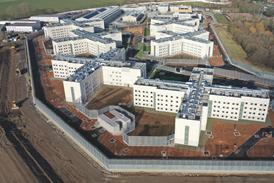The 2004 Regeneration Awards feature social landlords more prominently than ever. Elaine Knutt looked at what makes a good renewal scheme great
Cathy McCormick, a tenant participation officer at Manchester Methodist Housing Group, spent last weekend planting flowers. Not in her own garden but at the Northmoor Homezone estate in Longsight, with residents and Manchester Methodist neighbourhood wardens.
McCormick’s workload reflects the varied community regeneration responsibilities that Manchester Methodist and other registered social landlords are taking on. Her projects include working with environmental charity Groundwork Manchester on a piece of public art outside the Northmoor Community Centre, and discussing plans for a youth centre with the local Connexions team.
Most landlords now recognise that investment solely in the building stock of communities with low quality of life is effectively money down the drain, while helping an area get back on its feet makes good business sense. Like Manchester Methodist, they are looking beyond the interest of their properties and tenants, and making commitments to entire areas.
“The lift in the area is quite marked, even in the two years I’ve been working here,” says McCormick. It’s not surprising that, with terraced houses that changed hands for as little as £5000 a few years ago now worth up to £100,000, owner-occupiers and tenants alike have had pride in their properties and themselves restored, while crime and antisocial behaviour have declined. “It’s the little things – people have the confidence to put their pots and planters out without the assumption they will be destroyed,” she says.
Manchester Methodist is one of six RSLs shortlisted for the title of Housing Association Regenerator of the Year in the 2004 Regeneration Awards, organised by Housing Today’s publisher, CMPi.
RSLs also feature in other categories, taking their place alongside special purpose vehicles such as Nuneaton’s “Pride in Camp Hill”, generously funded initiatives such as Castle Vale’s housing action trust, private sector developers and government agencies such as English Partnerships.
This year’s crop of entries demonstrates that RSLs are coming of age as regeneration agencies. It’s not many years since some saw regeneration as an optional extra, an add-on to their core business neatly summed up in the name of the Housing Corporation’s Housing Plus funding programme.
More than good intentions
But as awards judge Bernard Hunt, managing director of HTA Architects, says: “Regeneration has emerged from a period where people treated it as a ‘challenge’.
It’s not just about good intentions and having a go, but also professionalism and really understanding the multi-dimensional processes.
“I don’t think anyone has it inside out and knows all the answers. Collectively, however, we’ve learned a lot in the past few years, and it’s beginning to come through in results.”
So what are the hallmarks of this professionalism? In Hunt’s view, in the same way as commercial developers are reshaping their businesses around regeneration, housing associations need a suitable corporate structure to be regenerators. He was very impressed by the North-west’s Harvest Housing Group, shortlisted for the Housing Association Regenerator of the Year. “They demonstrated great clarity in shaping their organisation to respond to the regeneration agenda. They have a whole philosophy around regeneration – it’s part of the way they think and breathe,” he says.
Harvest reorganised in 1999, specifically to free up resources and people to work in regeneration. As Kim Penfold, director of strategy and information, says: “We found there were neighbourhoods where just functioning as a landlord wasn’t in our interest or the neighbourhoods’ interest. We had some initiatives in employment training, but were conscious we were only doing some things in some places, and not necessarily transferring learning across the organisation or providing a consistent approach.”
The restructuring created a central service department to deal with tenancies, repairs and nuisance problems at Harvest’s three subsidiary housing associations. At the same time, it introduced a neighbourhood regeneration officer, retraining some former housing officers and appointing external candidates. Their job is to work with communities to identify projects they need – such as employment training, youth activities or environmental projects – to secure funding, and then make sure they happen.
Marie Johnson is the neighbourhood regeneration officer for Harvest’s Grove Village in Manchester, the country’s first housing private finance initiative. She sees her work as helping to make it a desirable address, and says initiatives such as a residents’ health club and a youth arts workshop have created an “upbeat feel on the ground”. She adds: “The bricks and mortar have improved confidence but people now know that, if they suggest something, it will be implemented.”
As social enterprises, regeneration is the perfect role for housing associations but most haven’t reorganised their business streams or developed the right skills
Chris Brown
Having switched two years ago from a housing officer role, she appreciates that her new job is “about doing all the things you’d have liked to have done as a housing officer, but had limited capacity to deliver”.
Riverside Housing, another on the shortlist for Housing Association Regenerator of the Year, has also restructured and diversified to be fit for purpose as a regeneration agency. To build up its financial resources, it has gone into the timber-framed housing business in a joint venture with a commercial company, and become a commercial property landlord.
It plans to develop social enterprises and environmental businesses through Riverside Enterprises. It has also created a team of seven community investment staff, supported by 30 others, who combine community regeneration with traditional tenancy-related housing work.
Awards judge Chris Brown, chief executive of the Igloo Regeneration Fund, commends the way housing associations are responding to the In Business for Neighbourhoods agenda. “It’s creating a framework in which associations are getting more serious about regeneration as a business stream.” But he adds: “They can go an enormous distance further. As social enterprises it’s a perfect role for them, but most haven’t reorganised their business streams or refocused their businesses or developed the right skills.”
Adam Sampson, awards judge and director of Shelter, was impressed by the associations that managed to create new and sustainable employment opportunities. He feels that regeneration has moved on from the view that success is a question of “importing” new jobs via inward investment, or giving people skills that they promptly take elsewhere. “I liked building on what was in the community already, rather than replacing it,” he says.
Keeping it local
Leicester Housing Association, also shortlisted for Housing Association Regenerator of the Year, has shown how to create new jobs for the community. It has helped local people to acquire construction and maintenance skills: not-for-profit contractor Newlife Regeneration turned over £6.5m last year, and recently created 130 jobs or training places as it refurbished 200 homes in the Braunstone area.
“Our emphasis is on local people and local supply chains. We’re not bringing in contractors from outside,” says Robert Nettleton, director of development and regeneration. After investing £28m in stock improvements in the Meden Valley coalfields area in Nottinghamshire/ Derbyshire, Leicester HA set up six “village companies” as umbrellas for social enterprises that create sustainable jobs and return profits to the community. Examples of new businesses it has supported include The Village Chippie in Whaley Thorns and a printing business in Langwith. There are also plans for an area-wide care co-operative. “There’s a great need for jobs and training, but there is also a gap in care services here,” says Lyn Williams, project manager for the village companies. She feels the regeneration effect since 2000 would not have happened if Leicester HA had withdrawn after the stock investment.
“Things have improved here but you need more than one approach. The village companies have been very good at capitalising on the skills people have but would otherwise never be used.”
Most developing associations have experience of partnering in physical regeneration projects, but one judge felt many still behave too often as channels for section 106 planning gain agreements – struck between council planners and developers – rather than fully fledged partners. “When you look at the resources associations bring to the table, I don’t think they’re achieving enough,” says judge Ken Dytor, chief executive of developer Urban Catalyst. “With their financing, property portfolios, regional and local networks and their access to local communities, they could offer a lot more.”
In Warwickshire’s Pride in Camp Hill initiative (shortlisted for Regeneration Agency of the Year), Touchstone Housing Association – part of Keynote Housing Group – has demonstrated one way to avoid being sidelined within section 106 agreements. As well as managing the 25% of social rented homes among 1000 new-build units built by Lovell Partnerships, it is setting up a resident-controlled management company to provide repairs, maintenance and support services to both tenants and owner occupiers, which should help to integrate the new community.
As some judges suggest, associations may not yet be delivering to their full potential as regeneration agencies. But Shelter’s Adam Sampson doesn’t want them to be paralysed by the fear of not getting it right.
“Do any of us really know what we’re doing? Is there an acknowledged handbook of regeneration? We’re at the very beginning of learning what does and doesn’t work. One doesn’t want to take risks with people’s lives, or waste scarce resources. But in the context of the little we know, failure is likely to produce as many valuable lessons as successful projects.”
Source
Housing Today
Postscript
The 2004 Regeneration Awards will be presented at the Hilton, Park Lane, London on Monday 29 November





















No comments yet